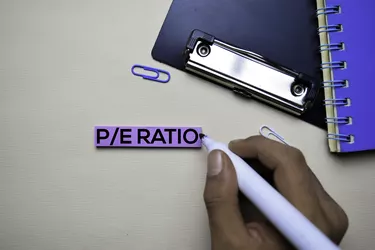
If you're considering purchasing a company's stock, you'll find it helpful to check the price-to-earnings ratio so that you can tell whether the particular stock is valued appropriately on the market. The P/E ratio is determined by dividing the current market price of the stock by the earnings each share generates.
By learning how to find and use a P/E ratio, you can make more informed investment decisions.
Video of the Day
Video of the Day
Understanding the P/E Ratio
The price/earnings ratio helps any investor monitor a stock's performance either over time or against competitors. Simply, it indicates the price that investors pay per every dollar the company earns yearly. So, if a company's P/E ratio is 10, then you'd be paying $10 for every $1 of annual company earnings.
This metric comes in a few different versions with the most commonly used being the trailing and forward P/E ratios. The trailing P/E ratio uses the current stock price and the earnings per share (EPS) from the previous year, while the forward P/E ratio uses the current stock price and a projected EPS for a future period. The trailing version is considered more accurate since it's based on actual past performance.
Exploring the Uses of the P/E Ratio
As an investor, you could use a stock's P/E ratio to determine whether the current stock price is too high, too low or just right and then use that information to help make an investment decision. For example, if the stock's P/E ratio seems too high compared to a similar company, this might be an indication the stock is overvalued and not a good buy. However, it could also indicate the stock's potential for growth despite some higher risk involved with such a stock.
On the other hand, a low P/E ratio in comparison to a competitor might indicate an undervalued stock that could perform better in the future, so you might opt to make an investment. But a low P/E value could also signal that the stock doesn't have a bright future and is seen as "cheap" for that reason.
You might also compare the P/E ratio of a specific stock over time to see if it's falling or increasing. If it continues to increase and appears overvalued versus competitors, you might decide to sell the stock to avoid a drop in the share price later on.
Finding the P/E Ratio Online
Since the P/E ratio has such importance to investors considering to buy a company's stock, you'll find it easy to locate the 12-month trailing version and avoid doing a manual calculation. You can simply look up the stock's ticker symbol on a financial website that shows up-to-date stock information such a Yahoo Finance or Nasdaq. For example, if you visit the stock's page on the Nasdaq website and look below the graph that shows changes in the stock's price, you'll find the trailing P/E ratio shown under "Key Data."
Calculating the P/E Ratio
If you want to calculate the forward or trailing P/E ratio, you can simply divide the stock's current per-share price by the EPS. Visit a financial data site like Nasdaq to quickly get the current stock price.
To find the EPS, you can often get the 12-month trailing EPS from stock websites, consult analyst websites for a future projected EPS or look at a company's latest financial report if you want to manually calculate the EPS for the last quarter. Manually calculating the EPS involves dividing the net income minus any preferred dividends by the average outstanding shares.
Once you have the current stock price and the trailing or projected EPS based on your needs, you can simply divide these two numbers to get the trailing or forward P/E ratio. For example, if Company A has a current stock price of $150 and a trailing EPS of $5, then the trailing P/E ratio would be 150/5, which is 30.
Using the P/E Ratio Effectively
Looking at a stock's current P/E ratio alone won't suffice for making an investment decision. So, you'll want to either compare its past and present performance or use a comparison to competitors to get a better picture of whether the P/E ratio is too high or too low. You'll also want to remember that a P/E ratio being high or low doesn't guarantee the stock's actually undervalued or overvalued. Further, stock performance can quickly change in a volatile market.
Using the P/E ratio along with performing thorough stock research and analysis that considers metrics like the EPS, return on equity, dividend yield and the price-to-sales ratio can help you get a broader picture of a company's performance.